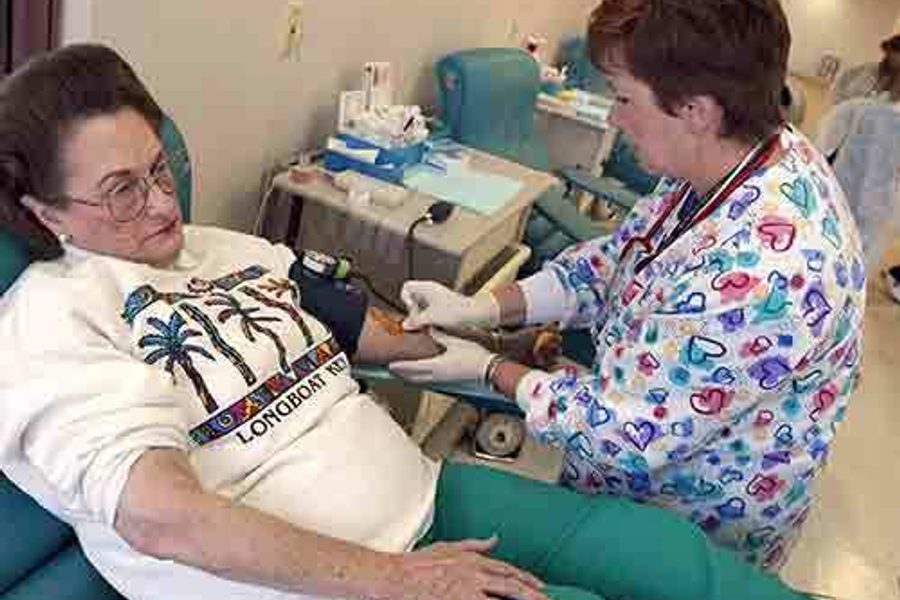
A national coalition of labor unions, consumers and health advocates called on the FDA Wednesday to crack down on the Red Cross’s ongoing failures to protect the blood supply, blaming draconian cost-cutting, high turnover and the hiring of less qualified workers.
At the same time, as part of a series of local actions, Red Cross workers in Southern California and Connecticut raised the possibility of strikes over poor working conditions — and the sharp cuts in registered nurses and other well-trained health workers needed to staff blood drives safely.
At a press conference in Washington, Arlene Holt, Executive Vice President of the AFL-CIO, declared,
The Red Cross has pursued workforce cost-cutting measures that result in running blood drives like fast-food restaurants. Workers report that Red Cross frequently understaffs blood drives, assigns workers to 14 hour days, and eliminates the most experienced, licensed medical personnel. These labor practices have created a low-morale, high-turnover workplace, increasing the risk of blood safety errors on the job.
These aren’t just union allegations, either. As consumer groups and patient advocates point out, for 17 years, the Red Cross has operated under a federal consent decree that requires it to clean up its blood safety practices.
Since 2003, the Food and Drug Administration (FDA) has fined Red Cross $21 million for blood safety violations. A coalition press release noted, “Last fall, the FDA issued a report on blood safety violations at Red Cross, citing 231 blood product recall events involving the distribution of 7,363 unsuitable blood components. “
“We believe the Red Cross is failing to take the steps needed to improve its safety practices. We are particularly concerned about the large number of blood products that were distributed despite the fact that Red Cross had already identified them as suspect or unsuitable. This is completely unacceptable from the consumer’s perspective,” said Sally Greenberg Executive Director, National Consumers League. “No one in America should have to worry that the blood they are receiving in a transfusion could be from a tainted blood product.”
Leaders of The Committee of Ten Thousand (COTT), named for ten thousand persons with hemophilia infected with HIV/AIDS through tainted blood products in the 1980s, were there to speak for the most vulnerable victims of American Red Cross (ARC) practices: hemophiliacs infected with HIV/AIDS and hepatitis C.
A spokesman for the group issued a statement filled with concern and outrage: “The level of ongoing violations at ARC is difficult to comprehend when one considers that this is about one of the most precious resources in our nation; The Blood Supply. For COTT, this remains an unacceptable situation that must be rectified with all deliberate national effort and will.”
Yet the American Red Cross’s spokesman sought to paint the wide-ranging concerns over the organization’s blood safety practices – and the $21 million in fines and court-ordered monitoring – as a mere “negotiating tactic.” As The Washington Post reported:
Red Cross spokeswoman Stephanie Millian questioned the motive behind the announcement, saying it came as unions are negotiating labor contracts at Red Cross Blood Services Regions nationwide. Millian called it “a negotiating tactic to try to gain leverage at the bargaining table…”“Calling blood safety into question as a negotiation tactic is highly disappointing,” Millian said. “The blood supply is safer today than ever before… . While the blood supply will never be without risk, people should not hesitate to donate or receive needed blood products.”
Yet that’s not the view of former Red Cross executives, medical experts and government officials who spoke to the New York Times in 2008 year about the crisis in blood supply safety. And the problems continue, as the FDA reported in an Oct. 30, 2009 report on thousands of tainted blood products. The underlying problems, as noted in the Times report, include:
Some critics, including former Red Cross executives, have even suggested breaking off the blood services operations from the rest of the organization, as the Canadian Red Cross did a decade ago.The problems, described in more than a dozen publicly available F.D.A. reports – some of which cite hundreds of lapses – include shortcomings in screening donors for possible exposure to diseases; failures to spend enough time swabbing arms before inserting needles; failures to test for syphilis; and failures to discard deficient blood.
In some cases, the lapses have put the recipients of blood at risk for diseases like hepatitis, malaria and syphilis. But according to the food and drug agency, the Red Cross has repeatedly failed to investigate the results of its mistakes, meaning there is no reliable record of whether recipients were harmed by the blood it collected.
Arlene Holt, among others, underscored yesterday how relatively low pay, high turnover and unskilled workers all contributed to the safety threats in our blood supply:
Employees are responsible for unloading heavy equipment, assessing donors’ health histories, conducting mini physicals, collecting blood and caring for donors after they give blood. This is serious work. But Red Cross employees report that understaffing makes it particularly difficult to ensure safety on blood drives. The problems of overbooking and understaffing are systemic. We believe this reflects a policy decision by Red Cross to abandon attempts to retain qualified staff.Red Cross has been eliminating or reducing the number of licensed nurses who work blood drives. In several regions, workers report that licensed nurses have been cut by as much as two-thirds over the past 10 years. This trend presents safety issues for both donors and transfusion recipients. Nurses are most qualified to respond to adverse reactions, including fainting episodes, injuries caused by needle puncture, allergic reactions and complications associated with “double red” procedures.
By trying to run blood drives on the cheap, Holt argued, there just aren’t enough trained workers to do the job right, endangering us all. Among the examples she cited:
In some areas of the country, Red Cross has taken mobile truck drivers and trained them as phlebotomists. Some of these workers have told us they’re not comfortable being responsible for drawing blood. They say they don’t have the experience or training to provide the best possible response if an urgent medical need arises…In Connecticut, Red Cross is currently trying to eliminate staffing ratios that the union believes provide greater safety, as well as reduce the responsibilities and authority of nurses. Workers report to us that four years ago, Red Cross in Connecticut had 30 nurses on staff. Now they are down to 11…
In California, Red Cross and other blood banks even received an exemption from State laws that require certification for phlebotomists…
In the NJ-Penn Region, the industry has lobbied to eliminate requirements for nurses on blood drives. We’ve received reports that 10 years ago, Red Cross had 75 nurses on its blood collection staff. Now they are down to 18.
At local press conferences, some union leaders highlighted not only safety concerns and understaffing, but the low wages and poor benefits that contribute to high turnover and a poorly trained workforce.
For instance, as the Glendale News Press reported Wednesday:
More than 300 nurses, blood collectors and other medical professionals have been in contract negotiations with Red Cross administrators since March, but have come to loggerheads regarding donor safety measures and restrictions to their health benefit options, said Therese Mendoza, a registered nurse with the organization. The represented workers are based at Red Cross facilities throughout Southern California.Employees voted May 2 to strike, she said.
“We are asking for a fair contract that maintains affordable family health care and fair wages,” Mendoza said at a news conference outside the organization’s Glendale-Crescenta Valley Chapter on South Brand Boulevard.
The employees have also been disputing a new blood collection practice, Mendoza said.
Two medical staffers are currently required to be with blood donors at collection sites, she said. But that protocol would change under the proposed contract to just one employee [and compromise safety for vulnerable donors.]
All told, there are about 3,000 unionized employees of the American Red Cross, although the exact percentage of the organization’s workforce that is represented by unions isn’t known. The unions, including Communication Workers of America and AFSCME, make up the Workers Committee for Blood Safety.
The group’s mission couldn’t be more important either to the workers or the public:
“Frontline blood drive workers of the Red Cross formed the Workers Committee for Blood Safety to address blood and donor safety issues at the Red Cross Blood Services Division and improve working conditions for all employees of the Red Cross. Workers at the Red Cross dedicate their lives to promoting blood donations to save lives.”
But that safety remains seriously at risk. On Wednesday, the National Consumer League’s Sally Greenberger drew the connection between working conditions and the risk to the rest of us:
We urge the FDA to fully investigate working conditions at the American Red Cross, including:* Employee safety errors due to long work hours and fatigue
* Reductions in licensed medical personnel on blood drives
* Employee relations practices that place greater reliance on low paid, inexperienced staff and
* High levels of employee turnoverWe believe it is unacceptable that, year after year, Red Cross continues to violate blood safety regulations which can expose the public to potentially suspect blood products that could present an elevated risk for HIV, hepatitis, syphilis, malaria, and Creutzfeldt-Jakob disease






